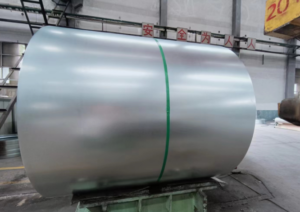Cold Rolled Steel (CRC) and Hot Rolled Steel (HRC) sheets are two of the most commonly used and vital types of steel sheets. While both CRC and HRC sheets are derived from the same basic material—steel—they exhibit significant differences in terms of their manufacturing processes, physical properties, mechanical characteristics, and end-use applications. In this blog post, we will delve into the difference between CRC and HRC sheets.

What is the difference between CRC and HRC sheets?
The Difference between CRC and HRC Sheets – 1. Manufacturing Processes
Let’s start with a brief overview of the manufacturing processes. Hot Rolled Steel sheets are produced by passing steel slabs through a series of rolling mills at high temperatures, typically above the steel’s recrystallization temperature. This process allows the steel to deform plastically and achieve the desired thickness and shape. On the other hand, Cold Rolled Steel sheets are manufactured by further processing hot rolled steel through cold rolling mills at room temperature or below. Cold rolling involves the use of powerful rollers to compress the steel, resulting in a thinner and denser material with improved surface finish and mechanical properties.
The Difference between CRC and HRC Sheets – 2. Physical Properties
The physical properties of CRC and HRC sheets differ significantly. Hot Rolled Steel sheets typically have a rough and scaled surface due to the high-temperature rolling process and oxidation of the steel surface. They also tend to have lower dimensional accuracy and tolerance compared to CRC sheets. In contrast, Cold Rolled Steel sheets exhibit a smoother and more uniform surface finish, as well as tighter tolerances and higher dimensional accuracy. CRC sheets also have a denser microstructure due to the cold rolling process, which results in improved strength and hardness.
The Difference between CRC and HRC Sheets – 3. Mechanical Characteristics
Moving on to mechanical characteristics, Hot Rolled Steel sheets generally have lower tensile strength and yield strength compared to Cold Rolled Steel sheets. However, they often possess better ductility and toughness, making them suitable for applications that require high deformability. Conversely, CRC sheets offer superior tensile strength and yield strength, making them ideal for applications that require high strength and stiffness. CRC sheets also exhibit better fatigue resistance and wear resistance due to their denser microstructure.
The Difference between CRC and HRC Sheets – 4. End-use Applications
In terms of end-use applications, Hot Rolled Steel sheets are widely used in construction, bridges, shipbuilding, and other heavy-duty applications where high toughness and formability are essential. Their lower cost and ease of processing also contribute to their popularity in these industries. On the other hand, Cold Rolled Steel sheets find their way into a range of precision manufacturing applications such as automotive parts, appliances, and electronic components. Their high strength, stiffness, and excellent surface finish make them suitable for these demanding applications.
The Difference between CRC and HRC Sheets – 5. Corrosion Resistance
Moreover, the corrosion resistance of CRC and HRC sheets also differs. CRC sheets, due to their smoother surface and denser microstructure, often exhibit better corrosion resistance than HRC sheets. This is particularly important in applications where exposure to corrosive environments is a concern, such as in certain chemical processing facilities or outdoor environments.
The Difference between CRC and HRC Sheets – 6. Weldability and Machinability
In addition to these fundamental differences, CRC and HRC sheets also vary in terms of their weldability and machinability. Hot Rolled Steel sheets tend to be easier to weld due to their lower carbon content and more uniform microstructure. However, Cold Rolled Steel sheets, with their denser structure and higher strength, may require special welding techniques and considerations to achieve satisfactory results. Similarly, machining CRC sheets can be more challenging due to their hardness and stiffness, while HRC sheets are generally easier to machine.
The Difference between CRC and HRC Sheets – 7. Cost
Finally, it’s worth noting that the choice between CRC and HRC sheets often depends on the specific requirements of the application and the desired material properties. Cost is also a significant factor, as CRC sheets typically command a higher price due to their superior properties and more involved manufacturing process.
Conclusion
In conclusion, Cold Rolled Steel (CRC) and Hot Rolled Steel (HRC) sheets differ significantly in their manufacturing processes, physical properties, mechanical characteristics, and end-use applications. CRC sheets offer superior strength, stiffness, and surface finish, making them ideal for precision manufacturing and high-strength applications. Conversely, HRC sheets provide good ductility and toughness at a lower cost, making them suitable for heavy-duty and cost-sensitive applications.
Thank you for reading our article and we hope it can help you to have a better understanding of the difference between CRC and HRC sheets. If you are looking for CRC and HRC sheets suppliers and manufacturers online now, we would advise you to visit Sino Stainless Steel for more information.
As a leading supplier of stainless steel products from Shanghai China, Sino Stainless Steel offers customers high-quality stainless steel strips, stainless steel coils, stainless steel decorative sheets, stainless steel tubes, stainless steel pipes, stainless steel plates, and stainless steel bars at a very competitive price.
 :+86-13012867759
:+86-13012867759  :export86@sino-stainless-steel.com
:export86@sino-stainless-steel.com
For example, those who are pregnant, breastfeeding or involved in strenuous physical activity may be marginally deficient in thiamine x priligy generic App Academy is just as expensive as Lambda School, but it s faster paced, but I m sure that you can handle it